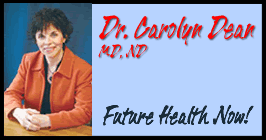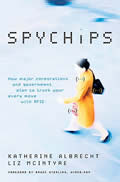Other
Dean
Articles:
MODERN MEDICINE'S NEED TO DESTROY NATURAL HEALING ARTS
Dr.
Carolyn Dean, MD, ND and
Elissa Meininger
December 15, 2005
NewsWithViews.com
As the health freedom movement grows and the failed ideas and corrupt practices of modern medicine become more evident to the general public, it is important to keep in mind that the world of medicine has always been split on two basic points: how to view illness and the real role of the doctor. Medical historian, Harris L. Coulter, Ph.D. called this split, the �Divided Legacy�, and wrote a series of four in depth and well-footnoted volumes about the history of Western medicine from Hippocrates to what he calls the �Bacterial Age�. His series is the primary reference source for scholars in the field.
In a review of the first three volumes of Coulter�s series, Homeopath, consultant to the World Health Organization, and a member of natural healing arts advisory boards at both Columbia and Harvard Schools of Medicine, Dana Ullman, M.P.H., provides a summary called �The Philosophical and Historical Roots of Holistic Approaches to Health�, a document that should be taken to heart by all serious students of medicine whether they be practitioners, researchers, policy makers, or members of the general public.
The schism of medical thought Coulter spent a lifetime writing about fell into two camps: the Rationalist School and the Empirical School. Since it took Dana Ullman 11 pages to condense nearly 1,900 pages of technical discussions regarding the philosophical differences between these two schools of thought, for the purposes of our column, we�d like to boil the schism down to the most critical issues so we can get on with our concerns about how this schism influences and corrupts our medical system today.
The Rationalist School, into which modern medicine falls, basically reduces all that is known about the function of a person into technical, abstract, mechanical terms that must be examined, one by one, as separate and individual issues. Furthermore, these issues must be explained in biochemical terms BEFORE a treatment can be developed. This approach guarantees that the uniqueness of individuals is not recognized. Also, professional conformity is ensured because treatments are standardized to treat as many people with the same symptoms as possible.
Rationalists believe that the physician is in charge of the healing process and the patient is subservient to the doctor. The power of nature is not recognized as part of the process. Consequently, if the theoretical model being used to treat the patient is at odds with the actual natural healing needs of the patient, there is no way to make appropriate adjustments in the process. Coulter points out that the fundamental weakness of the Rationalist system is that its proponents, who depend upon the latest technology available at the time, must continually come up with new theories in order to utilize these technologies as they become available. This results in the need to constantly discard previous theories and technologies if only to make way for new ones. The advancement of �science� is the main objective of the Rationalist School with its new theories of disease and modes of treatment and not the health of the patient.
Conversely, the foundational principle of the Empirical School is the idea that the body has an energetic essence, which includes the spirit, and operates as a whole system, not just a sum of its parts. Evidence confirming this school of thought was developed through clinical observation and note taking by many physicians from many cultures, over decades if not centuries, about modalities that worked to rebalance the system. Empiricists rely on these extensive historical references, passed down through generations of healers, to guide them in working with an individual to help restore them to health.
Empiricists may have some theory to explain what is happening to the person, but it is only an interesting side note because it is more important to get on with healing the sick. Another key principle is that instead of treating everyone with the same broad strokes, the uniqueness of individuals is central to selecting treatment options in the Empirical School. Professional independence is also assumed since there are many different ways to treat individuals and the symptoms they present.
In the Empirical School recognition of the force of nature within a person makes the physician/healer deferential to the natural process. Coulter points out that Empiricist health practices have a long history of use because they have proven to be so successful. Rationalist �science� does often not know the details of how and why they work and as we describe below, this is given as a reason to ignore Empirical medicine.
Empirical medicine basically encompasses all the natural healing arts Elissa and I write about in our columns. We would also like to point out that as a practical matter, the perspective and basic assumptions made by both schools of thought are either totally opposite to the other school or are totally incomparable at any level, thus trying to validate either school by using the assumptions of the other may not be possible.
Coulter�s third volume of �The Divided Legacy� focused on the practice of American medicine from colonial times to 1914, encompassing a period Elissa calls �The Golden Age of Health Freedom�. During the 1800s, due to public pressure to get rid of all licensing and other restrictive laws regarding the practice of healing arts in the US, creative ideas abounded. This attitude engendered the rapid growth of homeopathy as well as the birth of osteopathy, chiropractic, eclectic medicine, naturopathy, and several other natural health practices and movements.
The American Medical Association was organized in the 1840s, in part, to fend off public criticism of their bloodletting, use of toxic and often lethal mercury compounds, and the like. Since the AMA represented the interests of Rationalist medical practitioners, the AMA�s propaganda machine was put on overdrive to claim that its members� medical practices were based on �science� and accused all other healing arts of being �cults�, based on �dogma� that was �unproven� and �unscientific�. The public could have cared less about this professional name calling campaign and practitioners of Empiric healing arts had plenty of evidence of success including lots of happy customers.
However, after the Civil War, the balance of power changed. Several drug companies had made a fortune selling mercury compounds to the Union Army and it was obvious that if these drug companies wanted to continue prospering, they would have to come up with new products year after year, and make sure the purveyors of these products knew their virtues. Thus, the Faustian deal between Rationalist doctors and Big Pharma began, which now is obvious with the promotion of the ever-changing �flavor of the month drugs�.
The underpinnings of how this Faustian deal works are pretty basic.
First, in 1875, the Parke-Davis drug company invented the idea of publishing medical journals solely for the purpose of educating MDs about their product line. These publications, often just pamphlets, later became the full-blown �scientific� journals we know today. Their editorial pages were employed to condemn the competition, homeopathy being a favorite target. It wasn�t long before other drug manufacturers created their own journals and various medical societies went into the publishing business as well.
Coulter speculates that the proliferation of so many medical journals, 250 by the turn of the 20th Century, was a means of keeping large numbers of prominent MDs on the payroll to act as writers and editors and to provide prestige to the content, which was then sandwiched in between the ads pitching the never-ending array of new drug products coming out every year. Through purchase of expensive advertising pages, Big Pharma could also finance the political ambitions of the medical profession itself. According to the Journal of the American Medical Association, in 1900, not a dozen of the 250 medical journals published, made any real distinction between advertisements and editorial matter.
The idea of promoting the drug industry via �scientific� medical journals was a rousing success, right from Day One. In 1880, there were 2,700 products on the market. By 1885 there were 8,000 and by 1916 there were 39,000.
Besides creating an ongoing means of �educating� doctors to use the new products via �scientific� journals, they also developed the high art of sponsoring hospitality booths and suites at medical conventions to spread their message and butter up their customers with gifts and booze. This unethical tradition continues unabated. In my own neighborhood a group of MDs is regularly invited by their drug reps to a sumptuous dinner and given a $2,000 bonus for listening to a 30 minute after dinner talk on the latest drug.
Big Pharma also understood the necessity of sending personable sales people right into the doctors� offices who have the gift of gab as well as tangible giveaways and special favors to make it easier to pitch this year�s best, new, and often more profitable, product line. Big Pharma�s current favorite sales rep, according to the New York Times and reported in our News With Views article, �The Cost of Having a Stroke is Highway Robbery�, is a good looking cheerleader.
In recent months, there have been a number of high profile books and major news articles, including �Death by Modern Medicine�, covering the fact that medical journals have been duped into publishing corrupt scientific articles. These revelations have caused a hullabaloo in the medical industry prompting enterprising reporters from all over the world to engage in what seems a contest to see who can reveal the most about the fraudulent science papers. But, as you can see from Coulter�s excavating the history of medical journals, the publishing of less than honest and accurate �scientific� research is nothing new and certainly looks like the MO of these journals from their inception.
The most interesting article of this current crop of expos�s is one published on the Internet by Richard Smith, who for 25 years was an editor for the British Medical Journal. He wins the prize for most efficiently explaining in layman�s terms how the fraud is actually conducted.
His article, entitled, �Medical Journals Are an Extension of the Marketing Arm of Pharmaceutical Companies� should be read in its entirety.
Smith reinforces our previous statements that Big Pharma is an extremely lucrative and highly competitive industry that must come up with new products every year. Therefore, in a race to find a new blockbuster drug before the exclusive patent runs out on the old one, it is essential to get favorable scientific reviews. Such reviews once printed in prestigious journals, can jump start the next hoped-for moneymaker for the company. Just getting something published in a big name journal, reprinted and sent out to every doctor on the planet, can mean billions in increased worldwide sales. Smith even points out that many doctors won�t even bother to read the article but will be strongly influenced by the presence of the reprint sent to their office as a reminder.
When Big Pharma picks up the tab for a drug study, usually a clinical trial, there are at least eight quick and dirty ways to make sure of a favorable outcome and a great pro-drug published article according to Smith. They are:
1.
Conduct a trial of your drug against a treatment known to be inferior.
2. Trial your drugs against too low a dose of the competitor
drug.
3. Study your drug against too high a dose of a competitor�s
drug (making your drug seem less toxic.)
4. Fund trials that are two small to show any difference with
competitor drugs (therefore you can say yours is just as effective).
5. Use multiple endpoints in the trial and select for publication
those that give favorable results. (A shorter trial will have fewer
dropouts due to side effects.)
6. Do multicenter trials and select for publication results
only from centers that are favorable.
7. Conduct subgroup analyses and select for publication those
that are favorable.
8. Present results that are most likely to impress -for example,
reduction in relative rather than absolute risk.
Smith in his present article and Coulter from a historical perspective allow you to see that the economic pressure to present the development of new drugs in a good light, has prompted publication of fraudulent scientific papers all along.
In addition, the need to destroy competition from natural healing arts has been ever-present because when the general public has direct access to these other safer and more effective choices, they choose and support them.
This kind of discussion goes on all the time among those of use who work for health freedom. However, now that modern medicine has driven prices so high, and we have a real body count of death caused by modern medicine, it is time to rethink our public policy regarding medical and health matters. It may also be time for you and your loved ones to rethink the influence modern medicine has on you personally.
|
Subscribe to the NewsWithViews Daily News Alerts! |
By making available Dana Ullman�s summary of Harris Coulter�s highly acclaimed explanation of the schism in medical thought as well as the summary of how modern medicine routinely cheats in order to �prove� its superiority over its competition, we would like to believe this information, circulated widely among ordinary citizens as well as public policy makers will provide a means to start an honest reform of our health care system.
ACT
FOR HEALTH FREEDOM NOW:
Go to www.friendsoffreedominternational.org
view and purchase the new movie on Codex and Free Trade called "We
Become Silent" by Kevin Miller
Also purchase "Death
by Modern Medicine." Proceeds from the sale of these products
are crucial to help us fund our health freedom action. For state action
go to: www.nationalhealthfreedom.org.
� 2005 Carolyn Dean -
All Rights Reserved
Dr. Carolyn Dean is a medical doctor, naturopathic doctor, herbalist, acupuncturist, nutritionist, as well as a powerful health activist fighting for health freedom as president of Friends of Freedom International. Dr. Dean is the author of over a dozen health books, the latest of which is "Death By Modern Medicine".
Elissa Meininger, is Vice President of Friends of Freedom International and co-founder of the Health Freedom Action Network, a grassroots citizens' political action group. She is also a health freedom political analyst and can be heard on the natural health radio show SuperHealth, broadcast weekly on station WKY (SuperTalk AM 930) in Oklahoma City.
Website:
www.deathbymodernmedicine.com
Website: www.carolyndean.com
E-Mail: holeopharm@pol.net
Big Pharma and its health industry associates with their Gucci-shoe-clad
armies of lobbyists schmoozing in the cloakrooms with Washington DC�s
political power brokers or hiring cheerleaders as drug sales personnel
to add a little sex appeal while pitching the virtues of drugs directly
to doctors.










